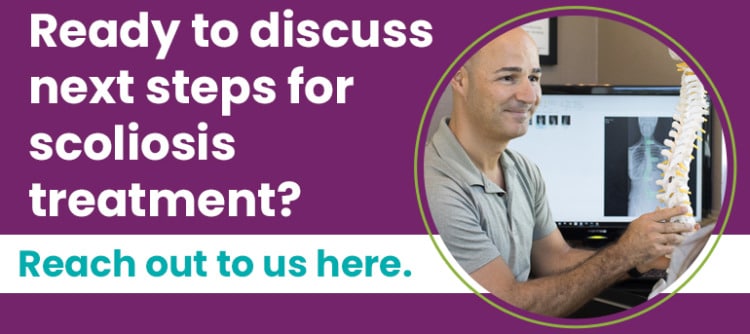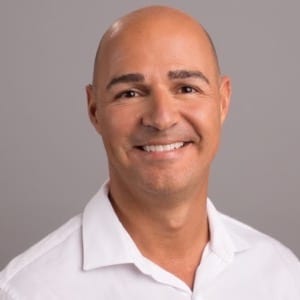5 Reasons to Treat Scoliosis Early Instead of Waiting

Scoliosis causes the spine to bend and twist unnaturally and can affect the entire body. As a progressive condition, the nature of scoliosis is to get worse over time, and as progression is triggered by growth, the best time to start treatment is always now.
There are no treatment guarantees, but there is a direct link between early detection, intervention, and treatment success. Addressing scoliosis early means being proactive by starting treatment while conditions are still mild and most likely to be responsive.
While modern conservative scoliosis treatment is proactive, traditional scoliosis treatment is more accurately described as reactive.
Table of Contents
Scoliosis Treatment Approaches
With current estimates at close to seven million people living with scoliosis in the United States, awareness is needed, and as scoliosis is the leading spinal condition among school-aged children, awareness can lead to early detection.
Scoliosis ranges widely in severity, and there are also different types a patient can develop, and curvature locations within the spine, so no two cases will be identical, which is why treatment plans need to be customized.
There are two main scoliosis treatment approaches: traditional treatment with spinal fusion surgery and conservative nonsurgical treatment options.
Scoliosis Surgery
Spinal fusion surgery involves fusing the curve's most-tilted vertebrae at its apex into one solid bone, and this often involves the removal of intervertebral discs sitting between adjacent vertebrae to be fused.
In most cases, metal rods are attached to the spine to hold its position, but this is contrary to the spine's movement-based design, so will affect the spine's long-term health and function.
Traditional scoliosis treatment was the dominant choice for many years, but that doesn't mean it's the best or only treatment option available.
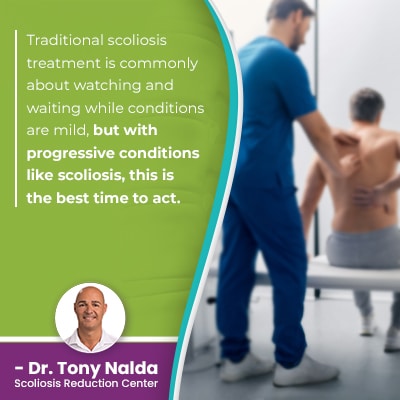 Traditional scoliosis treatment is commonly about watching and waiting while conditions are mild, but with progressive conditions like scoliosis, this is the best time to act.
Traditional scoliosis treatment is commonly about watching and waiting while conditions are mild, but with progressive conditions like scoliosis, this is the best time to act.
There are no treatment guarantees, but the milder scoliosis is when treatment is started, the simpler it's going to be to treat.
Conservative Treatment
Conservative scoliosis treatment provides a nonsurgical treatment alternative with proven results. The truth is that many cases of scoliosis are highly treatable and respond well to the nonsurgical treatment process.
Conservative treatment is modern and integrative and values what different disciplines can offer. Treatment plans are customized around a number of key factors: patient age, condition type, severity, and curvature location.
Condition-specific chiropractic care physical therapy, corrective bracing, and rehabilitation are combined and apportioned accordingly based on how the spine responds to treatment and/or growth.
Following a diagnosis, patients have an important decision to make: how to treat the scoliosis moving forward.
What's most important for patients to understand is that as a progressive condition, even if scoliosis is diagnosed while mild and isn't overly noticeable, it's unlikely to stay mild, and scoliosis that continues to progress and is left untreated can cause complications including digestive issues, breathing problems, mobility issues, and increasing pain.
So let's discuss 5 reasons why watching and waiting doesn't work.
1) Early Detection is Key
Scoliosis ranges widely in severity from mild scoliosis to moderate, severe and very severe scoliosis. The goal of scoliosis treatment is to stop progression, reduce the curve, and restore balance and stability to the spine and body.
The sooner the treatment process is started, the better because proactive treatment can work towards preventing progression, but this is harder to do in severe cases.
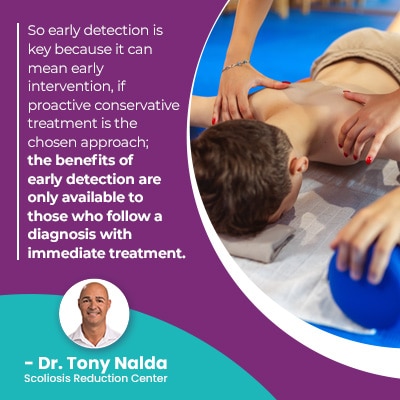 So early detection is key because it can mean early intervention, if proactive conservative treatment is the chosen approach; the benefits of early detection are only available to those who follow a diagnosis with immediate treatment.
So early detection is key because it can mean early intervention, if proactive conservative treatment is the chosen approach; the benefits of early detection are only available to those who follow a diagnosis with immediate treatment.
2) Progression is Triggered By Growth
Scoliosis affects all ages, but is most commonly diagnosed in children. The most prevalent type of scoliosis is adolescent idiopathic scoliosis diagnosed between the ages of 10 and 18.
So for adolescents facing the rapid and unpredictable growth spurts of puberty, this age group is the most at risk for rapid-phase progression.
Compliance can also be an issue with this age group, particularly when it comes to bracing treatment as teenagers don't want to look and/or walk differently from their peers, and they also don't want to have to wear a scoliosis brace to school, regardless of potential treatment efficacy.
Starting treatment early can mean helping patients avoid the need for full-time brace wear.
And as scoliosis gets worse over time, an adolescent watching and waiting can mean allowing the scoliosis to progress unimpeded while facing the constant trigger of growth.
If a patient is told to watch and wait and has a significant growth spurt that causes significant progression, the condition will be more complex to treat.
3) Delaying Treatment can Funnels Patients Towards Surgery
Delaying treatment can result in patients needing invasive surgical treatment in the future.
Scoliosis surgery is a type of spinal fusion, and while surgical treatment still has a place in severe, very severe, and atypical cases, the reality is that progression can be prevented in many cases, and like all surgical procedures, spinal fusion comes with risks.
One of the goals of proactive conservative treatment is to help patients avoid the potential risks, complications, and side effects of spinal fusion surgery.
Known risks, side effects, and complications can include nerve damage, infection, excessive blood loss, adverse reaction to hardware used, and a spine that's weaker, more vulnerable to injury, less flexible, and functional.
4) Scoliosis Effects Become More Established Over Time
As scoliosis is a progressive condition, its effects will become more noticeable alongside progression.
At the mild level, it can be difficult to diagnose children; scoliosis becomes a compressive condition once skeletal maturity has been reached.
It's not generally until scoliosis becomes compressive that it starts to be painful. Pain is the main symptom causing adult patients to seek assessment, diagnosis, and treatment.
In childhood scoliosis, postural changes are the most common symptoms, and these are caused by the uneven forces introduced to the spine and body.
Common postural changes can include uneven shoulders, shoulder blades, hips, and these changes get more overt as the size and rotation of the unnatural spinal curvature increases.
So watching and waiting while postural changes become more overt and become established make them more difficult to improve and/or reverse.
5) Scoliosis is More Responsive When Treated Early
When treated early, scoliosis can be highly treatable, and this is because the curve size is smaller.
As progression occurs, not only are the condition's effects becoming more overt and established, the spine will also become increasingly rigid.
Increasing spinal rigidity can be painful once compressive, and this also makes the spine less malleable and responsive to treatment.
In fact, in some cases where an adult's scoliosis has been left untreated, not getting diagnosed until after growth stops, preparatory work has to be done to restore a baseline level of spinal flexibility to prepare the spine for the regular course of treatment.
So if a progressive condition is virtually guaranteed to get worse over time, why watch and wait? Proactively managing scoliosis can mean preventing progression, increasing effects, and the need for invasive future surgical treatment.
Conclusion
The most important characteristic for scoliosis patients to fully understand is that as a progressive condition, it needs to be addressed proactively.
And as progression is triggered by growth, childhood scoliosis should always be taken seriously and addressed immediately.
Adolescent scoliosis is the most at risk for rapid advancement, and the age group affected are also the most vulnerable to mental health issues involving body image.
While the focus is often on the physical symptoms of scoliosis and the treatment process, there are also the condition's mental effects to consider, and watching and waiting isn't good for mental health.
Watching and waiting isn't going to motivate young patients with results, while being proactive and starting treatment early can help patients maintain feelings of power and control over their body, scoliosis, and life.
Here at the Scoliosis Reduction Center®, patients of all ages benefit from a proactive conservative treatment approach that's started as close to the time of diagnosis as possible because this is when scoliosis is most likely to respond well.
So reasons why watching and waiting can be risky include missing out on the benefits of early detection, growth triggering significant progression in children, funneling patients towards invasive spinal surgery, condition effects becoming more established, and the spine becoming more rigid and less responsive to treatment.
Dr. Tony Nalda
DOCTOR OF CHIROPRACTIC
After receiving an undergraduate degree in psychology and his Doctorate of Chiropractic from Life University, Dr. Nalda settled in Celebration, Florida and proceeded to build one of Central Florida’s most successful chiropractic clinics.
His experience with patients suffering from scoliosis, and the confusion and frustration they faced, led him to seek a specialty in scoliosis care. In 2006 he completed his Intensive Care Certification from CLEAR Institute, a leading scoliosis educational and certification center.
About Dr. Tony Nalda
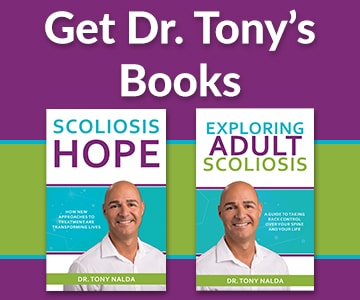 Ready to explore scoliosis treatment? Contact Us Now
Ready to explore scoliosis treatment? Contact Us Now